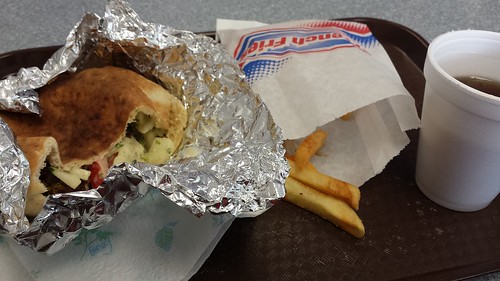“Global Food, Locally” is a series designed to introduce you to the International and Area Studies Library’s new graduate assistants as well local dining options for food from around the world. In our second installment, Sveta Stoytcheva reviews Jerusalem Middle Eastern Cuisine.
Like Quetzalli, I am also new to Champaign-Urbana and am eager to try out the different restaurant options the area has to offer. For this installment of Glocal Notes’ Global Food, Locally series, I visited Jerusalem Middle Eastern Cuisine. Middle Eastern food is some of my favorite and I was excited to find a go-to place in the neighborhood. I found out about the restaurant from a coworker, who included it among her list of local restaurants to try. This blog post provided me with the perfect opportunity to follow-up on her recommendation. The restaurant, located at 601 South Wright Street, is a short walk from campus and a great place to enjoy a weekday lunch.
The restaurant has a very casual atmosphere: there are two- and four-person diner style tables and the food served is on plastic cafeteria trays. The walls are minimally decorated and a row of plants lines the large windows on one side of the small restaurant. I went there around noon on a Wednesday afternoon and the place was busy with lunch hour customers –at least 20 patrons came through the restaurant as I finished my meal. Despite the traffic, it was quiet enough to read through lunch and the NPR News program playing quietly in the background seemed surprisingly appropriate. Although the décor isn’t exactly fitting for a special occasion, it is perfectly fine for a quick weekday meal. More importantly, the food itself is worth the trip.
Jerusalem has a pretty extensive menu and I had a hard time deciding what to order even after settling on a vegetarian dish. In addition to chicken and beef shawarma, kufta, and other meat entrees, the restaurant serves a variety of vegetarian options, including falafel, vegetable tagine, dolma, hummus, and lentil soup. Individually wrapped portions of baklava are for sale at the counter. (If you’d like to learn more about any of these foods, take a look at some of the Middle Eastern cookbooks available at the library.)
 Falafel sandwich special at Jerusalem Middle Eastern Cuisine.
Falafel sandwich special at Jerusalem Middle Eastern Cuisine.
To simplify things, I decided on one of the reasonably priced lunch specials and got a falafel sandwich, fries, and a spiced tea for just six dollars. The delicious tea is available either hot or iced in a styrofoam cup and, despite the warm weather, I decided hot tea was the way to go. Once you pay for your meal, you get a number and after a short wait (I waited about 15 minutes) your number is called and you pick up your order at the counter. I enjoyed my food, especially the falafel sandwich. In case you’re wondering, falafels are fritters made out of chickpeas (sometimes fava beans) and spices and often served with pita bread. In this case, warm falafels were served in a pita with diced tomatoes and cucumbers with a pleasant tahini and parsley dressing. In addition to lunch specials, Jerusalem offers several dinner specials after 4 p.m. I plan on coming back for a vegetarian platter with dolma and lentil soup!
Food is an important element of the various cultures of the Middle East. Although the region is very diverse, several common elements distinguish Middle Eastern food from other regional cuisines. Dishes are often cooked for a long time over low heat and feature a variety of spices, including cumin, sumac, saffron, and turmeric. Chickpeas (the main ingredient of both falafel and hummus) are very common, as are certain vegetables, such as eggplants (“V.B.1.” 2000). Apparently, there is a Middle Eastern saying that “to dream of three aubergines [eggplants] is a sign of happiness” (ibid).
If you are interested in learning more about the cultures of the Middle East, feel free to browse some of the International and Area Studies libraries offerings on the Middle East & North Africa Collections website or visit us in person. Additionally, you can attend the weekly brown bag lectures at the Center for South Asian and Middle Eastern Studies. The lectures cover a variety of topics and are free and open to the public. For your brown bag, food from Jerusalem Middle Eastern cuisine is available for take-out and I recommend giving it a try.
Jerusalem Middle Eastern Cuisine
601 S Wright St
Champaign, IL 61820
(217) 398-9022
Sources:
V.B.1. The Middle East and South Asia. (2000). In Cambridge World History of Food. Retrieved from http://proxy2.library.illinois.edu/login?url=/login?qurl=http://www.credoreference.com/entry/cupfood/v_b_1_the_middle_east_and_south_asia

